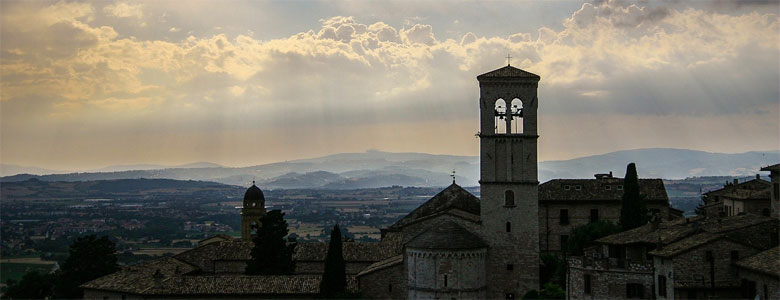Central Italy was hit by strong earthquakes in August and October 2016. The events were tragic and painful, killing 299 people, leaving hundreds more injured, and thousands without a home. The force of nature also raged against the artistic heritage of tiny villages in the regions of Umbria, Marche, Lazio and Abruzzo, destroying ancient palaces, churches and – in some cases – the entire historic center.
In today’s article, we want to pay tribute to all victims of the earthquake by giving an identity to this little-known part of Italy. We hope that homes and infrastructure will be rebuilt as soon as possible, and that works of art and architectural wonders will also be restored quickly. And we really hope that tourism will not stop because of fear, just like San Francisco continues being a popular destination despite the catastrophic earthquakes that hit it in the past. Visiting these hidden gems of Central Italy can help the local populations, who have always treasured their artistic heritage with pride.
If there is one image that symbolizes the impact of the earthquake on the artistic legacy of (central) Italy, it’s the photo of the Basilica di San Benedetto in Norcia, Umbria. Only its façade still stands, almost ironically to hide the destroyed building behind it. A symbol that goes beyond the “local”: the Church was the reference point for a large and international monastic community since the tenth century AD, and San Benedetto da Norcia (St. Benedict of Nursia) was proclaimed Patron of Europe in 1964. The Basilica, erected in the late 14th century, was physically located above the 5th century ruins of the traditional birthplace of St. Benedict. Among the paintings that were housed in this building, was a Madonna with Child from a local, late-Gothic painter.

Before and After in Norcia, Umbria
Norcia also lost the Concattedrale di Santa Maria Argentea, a Romanic church built in the 9th century, and the gothic-style Chiesa di San Francesco from the late 1300s, both of which had been rebuilt following earthquakes in the past centuries. The Museum of Castellina, the historic Municipal building, and the civic library were all heavily damaged by the 2016 earthquakes as well. The Church of San Salvatore, located in the village of Campi di Norcia, was one of the most important religious buildings in Umbria’s Valnerina Valley. It lost its important frescoes from the 1400s.
The artistic heritage hit by the earthquake in the Marche region includes the Church of Santa Croce in Arquata del Tronto. It featured a fresco dedicated to Madonna del Soccorso, a work of art that was created with the technique of painting on plaster by an unknown painter of the XV century. According to an ancient local legend, after days of incessant rain, the inhabitants of the mountain village were afraid that a landslide was inevitable. The priest decided to organize a procession headed by seven widows dressed in black and by seven virgins dressed in white. The procession reached the foot of the mountain, and the stones that had been falling for days stopped miraculously in front of the virgins. The inhabitants of Arquata del Tronto interpreted this rescue as a divine intervention by the Madonna del Soccorso.
Unfortunately, the list of destroyed or damaged buildings and works of art is long. And while they all deserve to be mentioned and remembered for the legends and historic importance behind them, we believe that it is also important for us to highlight what still stands and can continue to be admired by visitors who like to explore destinations off the beaten path.
One of the epicenters of the strong tremors that shook the earth in October 2016, was the charming protagonist of our article called “Fiastra: eco-tourism and family fun in the Marche region”. Several old buildings in and around Fiastra have been damaged by the earthquake, but local authorities hope that with the return of spring and summer, tourists will come back for the genuine flavors of local cuisine and for the amazing outdoor activities that can be enjoyed in the Monti Sibillini National Park and on the local lake, Lago di Fiastra.
Twenty-seven original manuscripts by Giacomo Leopardi, among which “L’Infinito”, were conserved in the ex-Church of Sant’Agostino, quarters of the Museo Civico Diocesano in Visso (Marche). The building collapsed… but fortunately the manuscripts had been taken to safety after the first tremors. Apparently, they will be transferred and kept in Bologna for the time being, but our hope is that they will soon return to the Marche region, birthplace of the poet and philosopher that is widely recognized as one of the most radical thinkers of the 19th century.

The beautiful buildings in Orvieto and Assisi
In Umbria, post-earthquake checks in the Duomo di Orvieto concluded that there were no severe damages to the building and its vaults. The cathedral’s façade is a classic piece of religious construction, containing elements of design from the 14th to the 20th century, with a large rose window, golden mosaics and three huge bronze doors, while inside resides two frescoed chapels decorated by some of the best Italian painters of the period with images of Judgment Day. Another religious building that has suffered no damages, is the Basilica of St Francis in Assisi. Here you can admire the amazing frescoes and decorations by masters Giotto and Cimabue, among others.
When visiting this region in the heart of Italy, you should not miss its striking medieval festivals that play an important role in the artistic heritage and livelihood of the local communities. One example is “Giochi de’ Le Porte” in September in the town of Gualdo Tadino, which hosts ancient games including a Palio, a race on donkeys (without the saddle), and an archery competition. Take advantage of your stay here to learn about how the city was famous in the Middle Ages for the manufacture of ceramic ware; and how still today it is an important center for the manufacture of industrial ceramics and bathroom fittings. Enjoy some experiential tourism by joining a ceramics course with your family and friends!

One of Leopardi’s manuscripts, and Villa Farnese in Caprarola
August’s earthquake destroyed the town of Amatrice in Lazio. The tremors of October caused some minor damages in other towns of this region, such as in Nepi, where a Medici’s decorative ball fell in the municipal palace. In Nepi, famous for its mineral springs, you can admire Rocca di Nepi or Castello Borgia, a 15th-century reconstruction of a feudal manor with massive walls and four towers. In the vicinity, you should not miss Caprarola’s Villa Farnese, a pentagonal Renaissance mansion that dominates the surrounding countryside. One of the palace’s most representative rooms is the Stanza del Mappamondo (Room of the World Map), which takes its name from the frescoes by Giovanni Antonio da Varese.
The areas hit by the earthquake are quite known for the delicious local cuisine. It is characterized by genuine flavors that rely heavily on seasonal ingredients found growing in the rich soil, swimming in the lakes, raised on local farms, or discovered in the lush forests that cover much of the region. If you would like to help local food businesses that were affected by the tragedy, you can buy their products by visiting their shops when visiting Italy, or by having a look at whether they accept to ship internationally. You can find a list of large and small, family-owned businesses here. A small action can make a huge difference for the inhabitants of Central Italy!



